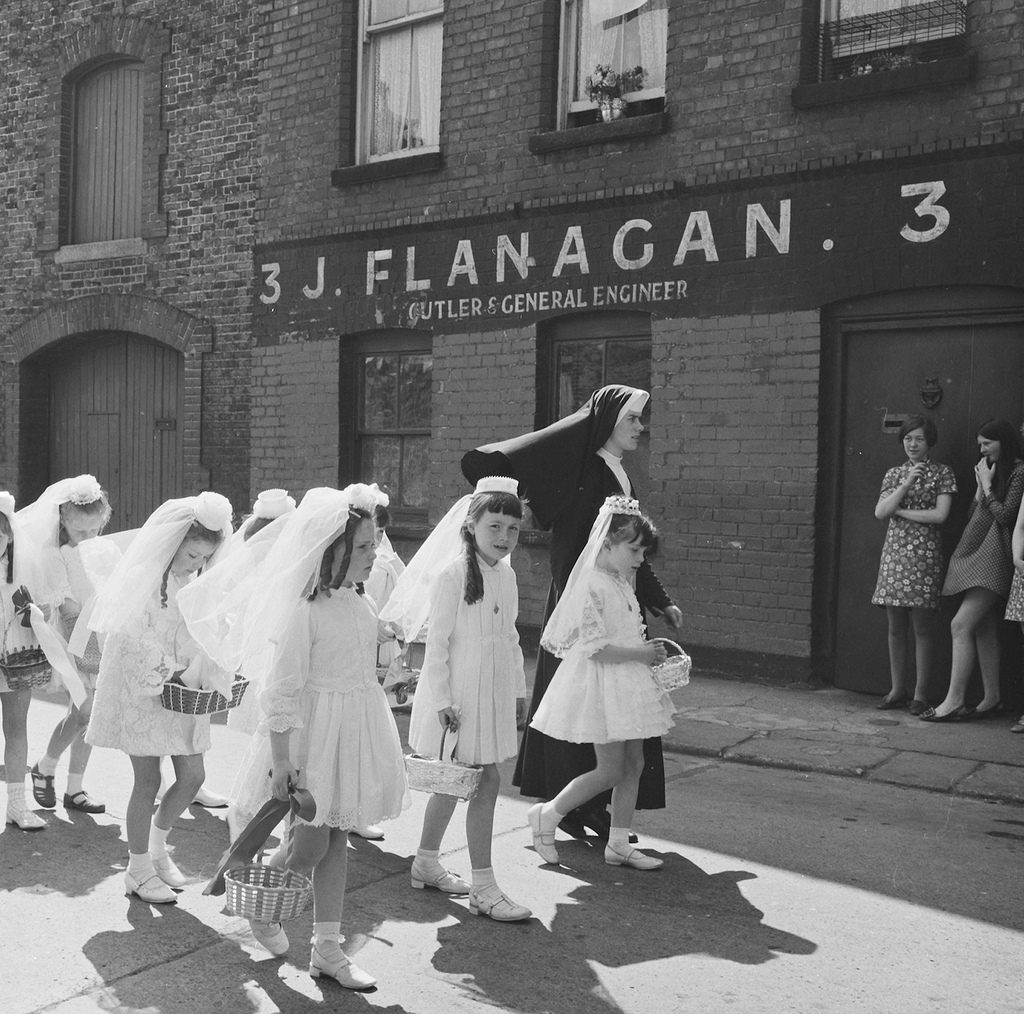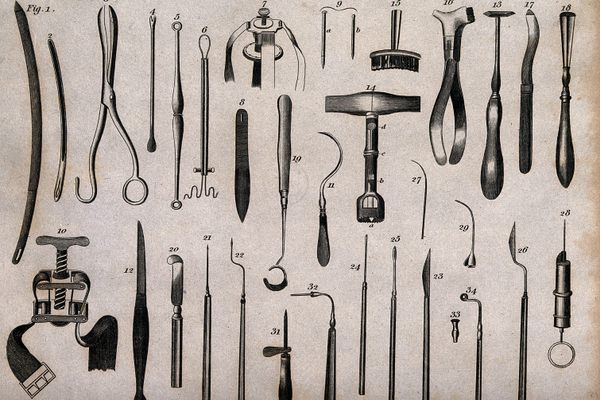The Invisible Unmarried Mothers of Ireland
For seven decades, thousands of pregnant Irish women were sent into a kind of captivity.

For many years now, stories about the conditions at the now-shuttered Bon Secours Mother and Baby Home in Tuam, Ireland, have circulated among locals. Little by little, those stories started gaining wider reach. The children who lived there never learned to speak correctly. They had lice in their hair. There was a pile of bones in the septic tank in one corner of the grounds.
Earlier this month, an investigative commission in Ireland confirmed what locals and advocates had long suspected: there was an unofficial, unsanctified tomb at the Mother and Baby Home, where “a number”—likely dozens, if not hundreds—of fetuses, babies, and children as old as two or three had been buried.
As recently as the 1970s and ’80s, if an unmarried woman in Ireland became pregnant, she might have been sent to give birth at a place like Tuam. Run by religious orders but funded by the government, mother-and-baby homes operated as quasi-public institutions for decades, starting in the 1920s. Their main function? To hide out-of-wedlock pregnancy from public view.
Women who gave birth in these homes were given little choice about keeping their children—almost universally, their babies were left in the care of the homes. Since 2015, Ireland’s Mother and Baby Home Commission has been investigating such institutions in order to report on the circumstances in which women were admitted, the living conditions at the homes, and their mortality rates and post-mortem practices.

The system that kept unmarried mothers and their children from sight, though, was more extensive than the 14 institutions under investigation. Mother-and-baby homes were part of an interlocking set of organizations, both publicly and privately funded, that tried to control the scandal of babies born outside of marriage. Once in this system, women and their children could find it difficult to disentangle themselves from it.
“After 1922, in order to project Ireland as a Catholic and morally pure society, the new fledgling political state deferred responsibility to Catholic religious orders for education, health, and social welfare policy,” says James Smith, an associate professor at Boston College and author of Ireland’s Magdalen Laundries and the Nation’s Architecture of Containment. “They contained and confined and rendered invisible what Irish society didn’t want to be confronted with. They allowed most people to buy into the fiction of a holy, Catholic Ireland.”

Mother-and-baby homes were not found only in Ireland; some of the first homes were set up by an order of nuns based in England, where there were similar institutions for unmarried mothers, some run by Protestant and lay groups. In Ireland, though, the homes were closely associated with the Catholic Church, which abhorred women who became pregnant outside of marriage.
“It was the greatest scandal,” says Smith. “It threatened the respectability of the family. It impacted opportunities for siblings. It would result in the Catholic priest coming to knock on the door and instruct the family to send the girl out of the house and out of the village.”
Most of these women had few options. Abortion was (and remains, for the most part) illegal in Ireland. Adoption was only made legal in 1953. There were private institutions dedicated to hiding pregnant unmarried girls, but for those without money, entering a mother-and-baby home and leaving the child there was often the only choice.
After giving birth, the new mothers were required to stay and work at the home for as long as two years, caring for their child and the other children who lived there. If a family wouldn’t take the unmarried mother back and she couldn’t support herself, she might then be sent to one of Ireland’s Magdalene laundries, also run by religious orders, where “fallen women” were confined and made to work for free. Separated from their mothers, the children born in mother-and-baby homes were often sent as five- or six-year-olds to “industrial schools,” set up by religious orders to care for orphaned or neglected children. Sometimes they were illegally adopted to faraway families, in England, Germany, or the United States.
Thousands of people passed through these institutions: in 1951, for instance, there were 1,983 women and children held in mother-and-baby homes and Magdalene laundries across Ireland, plus 5,844 children in industrial schools. The conditions in these places could be “Dickensian,” say advocates and historians: in the early decades of mother-and-baby homes, nuns might oversee a birth without the help of a midwife or doctor, and children were not well-fed or well-cared for. While institutions like these might be expected to have a slightly higher mortality rate than the general population, before the 1950s, the mortality rate for children under one year living in mother-and-baby homes could be five times as a high as for the country overall, Smith says.

Some pregnant women tried to leave Ireland for the less stringent conditions of mother-and-baby homes in England. There, there was still shame associated with being an unmarried mother, but the homes were usually less restrictive than in Ireland.
“If an unmarried mother found herself in a mother-and-baby home in Ireland, the minimum about of time that she’d have to spend in such a home was two years,” says Paul Garrett, a senior lecturer at NUI Galway, who has studied the movement of these “Pregnant From Ireland” women. “That’s a considerable chunk of someone’s life. If they got a ferry over to England, after staying in a mother-and-baby home, they could go after three months. There were considerable advantages to them.”
Catholic organizations, though, feared that Irish babies born in England might be adopted to Protestant families. So they worked to identify these women, convince them to come back to Ireland, and connect them with Catholic mother-and-baby homes. One organization, the Catholic Protection and Rescue Society of Ireland, took anywhere from 100 to 230 mothers back to Ireland each year for decades, and in total assisted in the repatriation of 2,600 unmarried mothers, Garrett has found.
While the Tuam revelations have made big headlines, advocates think the scandal should extend to the day-to-day conditions in these homes, too. “Why did these children die from malnutrition or commonly treatable ailments?” asks Mari Steed, the U.S. coordinator for the Adoption Rights Alliance, an advocacy group based in Ireland. “Those are the bigger questions.”
Steed is part of a group of advocates who have been working for years now to uncover different parts of this story. She was born in Ireland and adopted by an American family early in life, and around the time she was looking for her birth mother in the 1990s, an archivist at the National Archive in Dublin was clearing out a storage area when she came upon records detailing the adoption of 2,000 Irish children to American families. Around that same time, a mass grave was found at a Magdalene laundry, which intensified interest in these institutions, the last of which closed in 1996. Steed, whose birth mother had also spent time in one of the laundries, is a co-founder of Justice for Magdalenes, which pushed, successfully, for the Irish government to officially apologize for the laundries.

The current mother-and-baby commission doesn’t go far enough in the scope of its investigations, Steed and other advocates believe. “They need to look at all those different routes that fed adoption in Ireland,” she says, including private institutions.
Although more details about conditions in mother-and-baby homes and other religious-run institutions are coming to light now, the homes and the conditions there were never entirely secret. There were concerns within the government as early as the 1930s about mother-and-baby homes, and Smith, the historian, says that middle-class families would warn their children that they’d end up in these institutions if they went down the wrong path.
“One thing that’s emerging more recently is the ways in which these institutions had traffic passing between them,” he says. A woman might have grown up in an industrial school, released with little sexual knowledge, been confined to a mother-and-baby home once she got pregnant, and sent to a Magdalene laundry afterwards. This whole system of “coercive confinement,” as one scholar calls it, could capture people and punish them for years for their behavior without any judicial process. Once inside, they would disappear.









Follow us on Twitter to get the latest on the world's hidden wonders.
Like us on Facebook to get the latest on the world's hidden wonders.
Follow us on Twitter Like us on Facebook